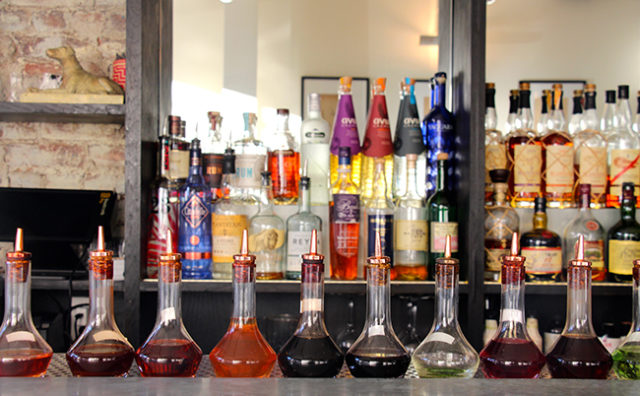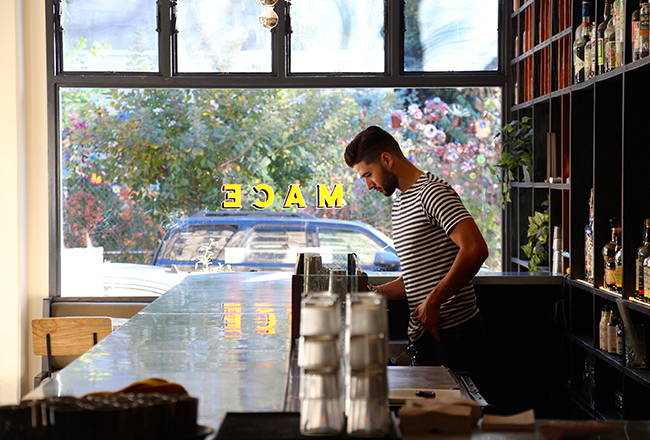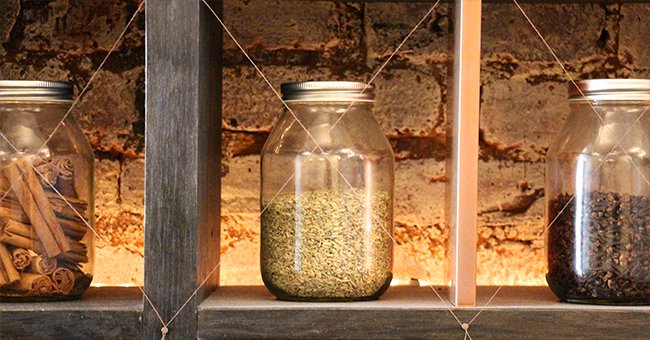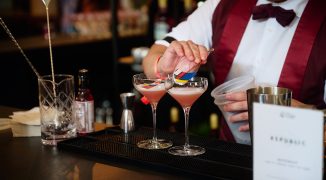A brand new sign on an otherwise dreary block of Avenue C in New York spells out MACE in large capital letters. In this neighborhood, it could be anything.
“Some people think it’s like the pepper spray,” says co-owner Nico de Soto. “It’s a spice.”
MACE is the bar that spice built, with an entire cocktail menu created around exotic flavors. The interior décor channels “modern spice shop” with classic store shelves holding mason jars half-full of colorful, unmarked spices. While spices take center stage, it’s the collection of bottles behind the bar that grab your attention. The liquors range from obscure to semi-obscure name brands from far off places, with plenty of unmarked, homemade tinctures off to the side. MACE is like an alcoholic apothecary of sorts, where each bottle has a story of some kind.
 MACE experiments with plenty of housemade infusions, like a cumin and dill vodka infused on-site for 24 hours.
MACE experiments with plenty of housemade infusions, like a cumin and dill vodka infused on-site for 24 hours.
Originally, de Soto wanted to name his bar after a different spice: clove. (He changed his mind after finding out New York City already had a Clover Club.) In the end, he chose mace both because “it’s a super-spice” and because foreign visitors could pronounce it.
“Mace is the skin around nutmeg. You have to grind it immediately, and it takes several kilos of nutmeg to make one kilo of mace,” explains de Soto.
Much like mace’s uniqueness in the spice world, MACE’s approach to cocktails stands out in the bar world.
“Basically, I wanted to do something original. I wanted to do a cocktail list according to travels,” explains de Soto, who first got into bartending on a whim when he found himself in need of money while backpacking around Australia for two years. He has traveled extensively since then, and different spices remind him of different destinations.
“Spices are a good link to bring flavors together. For example, my cinnamon cocktail is a twist on a pisco sour I had on the streets of Chile,” explains de Soto.
De Soto thinks of his cocktails as “drink concepts,” in which the spice comes up organically during the building process. “I make a concept or flavor combination first and the spice comes with it,” he explains. “Spices are a link for flavors. I think in terms of flavors instead of in [terms of] spice on its own.”
 Bartender Thibault Mequignon preps spices for cocktails.
Bartender Thibault Mequignon preps spices for cocktails.
MACE has three bartenders including de Soto, all veterans in craft cocktails. Thibault Mequignon is the bar’s newest hire. Like De Soto, Mequignon came to New York from France via London, where Mequignon worked in the Experimental Cocktail Club in London for three years.
“It’s a new way to approach drinks,” says Mequignon. “The Experimental Cocktail Club is in London’s Chinatown, so we were around tons of spices. I discovered new foods and spices all the time. I’m used to working with lots of seeds, plants and herbs.”
When de Soto says that “spices came easy” to him because he’s been cooking since he was a child in France, Mequignon nods.
“Unlike in cooking, it’s more complicated to find flavor combinations in drinks,” says Mequignon. “Sometimes it’s a challenge to play with what you eat and put it in drinks.”
As far as determining what spices go with which spirits, MACE’s answer is that there’s no wrong answer.
“I think you can mix every spice with every spirit. Ginger goes with everything,” says de Soto. “The toughest one to mix with spices is Scotch, but it can be done.”
 Cocktails at MACE have unique finishing touches, like tobacco spray.
Cocktails at MACE have unique finishing touches, like tobacco spray.
MACE’s menu backs up that statement. The drinks list is full of spicy combinations most people would never think to drink, like a cumin and dill vodka infused on site for 24 hours. There are no commonplace ingredients in a MACE cocktail, however. The Grass, for example, has silver needle white tea-infused shochu, grass cordial and grapefruit oil. The most popular cocktail is the Pandan, a surprisingly sweet mix of Trinidadian rum, Jamaican rum, Batavia arrack infused with pandan leaves, clarified milk, pineapple juice, lime juice, aman black tea, coconut water, ginger juice and spices.
The final touch is the glassware, which is equally unique. The Grass is served in a Japanese tea cup. A now defunct espresso martini was delivered in a coffee cup. The Dill, a dill-infused tequila drink mixed with matcha syrup, Mexican horchata, and tapioca pearls, comes in a domed plastic bubble tea cup, with an extra-wide straw.
Next up for the seven-month-old MACE: change. MACE will alter its cocktail creations every few months to keep things fresh. De Soto likes to keep a steady 14 drinks on the menu, which means that as new ideas come in, old ones have to go.
As the old adage goes, variety is the spice of life.





